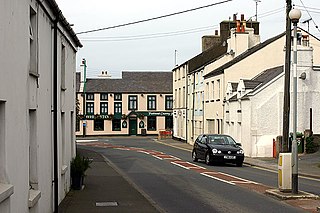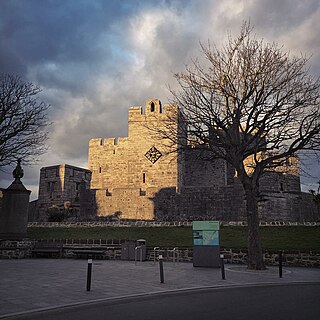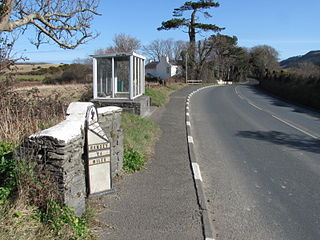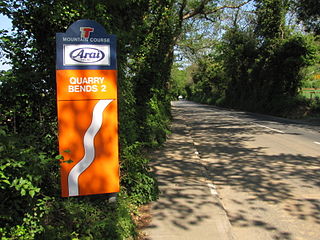
The Isle of Man is an island in the Irish Sea, between Great Britain and Ireland in Northwestern Europe, with a population of almost 85,000. It is a British Crown dependency. It has a small islet, the Calf of Man, to its south. It is located at 54°15′N4°30′W.

Heckington Windmill is the only eight-sailed tower windmill still standing in the United Kingdom with its sails intact.

The South Barrule is the highest hill in the south of the Isle of Man. It has the remains of a fort on its summit, which is traditionally the home of the Manx god of the sea Mannanan beg mac y Leir. The hill is largely surrounded by conifer plantations. On the south western slope of the hill the Cringle Reservoir was formed to supply water to the southern part of the island. South Barrule's ancient name was Warfield or Wardfell.
St John's is a small village in the sheading of Glenfaba in the Isle of Man, in the island's central valley. It is in the House of Keys constituency of Glenfaba & Peel, which elects two MHKs.

Ballasalla is a village in the parish of Malew in the south-east of the Isle of Man. The village is situated close to the Isle of Man Airport and 2 miles (3 km) north-east of the town of Castletown.

The Catholic Church in the Isle of Man is part of the worldwide Catholic Church, under the spiritual leadership of the Pope in Rome.

Castle Rushen is a medieval castle located in the Isle of Man's historic capital, Castletown, in the south of the island. It towers over the Market Square to the south-east and the harbour to the north-east. The castle is amongst the best examples of medieval castles in Europe and is still in use as a museum and educational centre.
Barregarrow is a district located between the 13th milestone and 14th milestones on the A3 Castletown to Ramsey road including the area of the Barregarrow cross-road junction and the C4 Ballaleigh Road and B10 Sartfield (Brandywell) or former Barregarrow mountain gate road in the parish of Kirk Michael in the Isle of Man.

Burnham Overy Staithe Windmill is a Grade II* listed building tower mill at Burnham Overy Staithe, Norfolk, England which has been converted to holiday accommodation.

Highroads Course was a road-racing circuit used for the Gordon Bennett British Eliminating Trial held in the Isle of Man for the 1904 and 1905 Tourist Trophy Race involving touring automobiles and cars. The events were held on public roads closed for racing by an Act of Tynwald.

The following outline is provided as an overview of and topical guide to the Isle of Man:

Reed Mill is a tower mill in Kingston, Kent, England that was built in the early nineteenth century and worked until 1915, after which the mill was derelict. In 2010–11 the mill was converted and extended to form residential accommodation.

Nyetimber Mill is a grade II listed tower mill at Pagham, Sussex, England which has been converted to residential use.

Shiremark Mill, also known as Kingsfold Mill or Capel Mill was a listed Smock mill at Capel, Surrey, England, which was burnt down in 1972.

The Silver Burn or Silverburn River is a small river, about five miles (8 km) long, on the Isle of Man which rises near the South Barrule and flows south. It passes St Mark's and in its lower reaches it flows under the Monks' Bridge at Ballasalla, and reaches the sea at Castletown harbour. Just above Ballasalla, the burn runs through wooded Silverdale Glen, a site which the Manx National Trust acquired in 1966.
Ballacobb is situated between the 16th and 17th Milestone road-side markers on the Snaefell Mountain Course, on the primary A3 Castletown to Ramsey road at the side-junction with the tertiary U16 Slieu Curn Road, in the parish of Ballaugh in the Isle of Man.

Alpine Cottage including the adjacent Alpine House is situated between the 16th and 17th Milestone road-side markers on the Snaefell Mountain Course on the primary A3 Castletown to Ramsey road in the parish of Ballaugh in the Isle of Man.

Bishopscourt consists of a 17th-century mansion house, the St Nicholas in the Church of England Diocese of Sodor & Man, and the former estate of Ballachurry or Bishopscourt Manse. Previously the official residence of the Bishop of Sodor and Man, the current Bishopscourt House and estate are now in private ownership.

Quarry Bends is situated adjacent to the 20th Milestone road-side marker on the primary A3 Castletown to Ramsey, in the parishes of Ballaugh and Kirk Christ Lezayre in the Isle of Man.



















